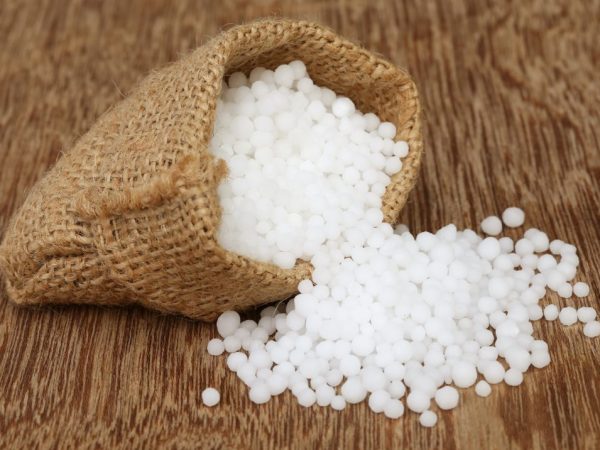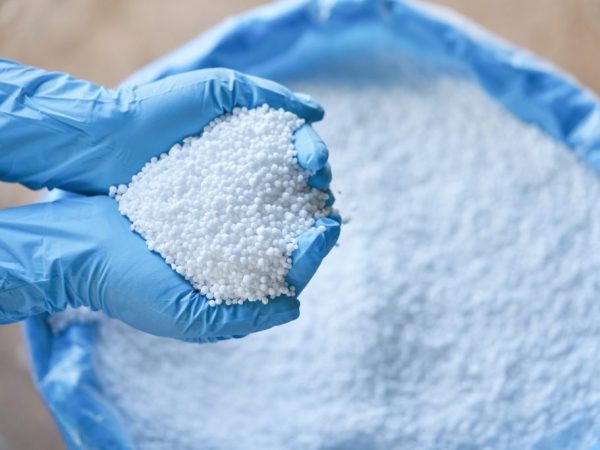Potato urea as fertilizer
There are a huge number of agro-technological methods for growing vegetables. Some methods and plant nutrition are used in private farms and in summer cottages. For a guaranteed excellent harvest in the autumn, you should prepare the land for sowing in advance in the spring. The most effective fertilizer is urea for potatoes. Among the wide variety of current substances and classic basic dressings, the treatment of plantings with urea can save your potatoes from the deficiency of many vitamins, and in particular, replenish the plantings with nitrogen. Many gardeners use urea in combination with other types of minerals.

Potato urea as fertilizer
Urea application
Fertilization with urea during planting makes it possible to protect young shoots from many diseases and almost all probable viruses. After planting, the first spraying is performed, until the first buds appear, and a significant proportion of parasites wintering on the crop in this case do not attack the planting. Summer residents see the key advantages of carbamide already before the initial harvest. A number of positive qualities of urea give it the right to be called a universal remedy.
Proper care of crops guarantees an intensive increase in size and abundance of almost all grown fruits. But the same cannot be said about potatoes, since this is an exceptional vegetable, growing which, there are problems with the assimilation of fertilizer brought to the garden. In a sense, potatoes are an extremely whimsical vegetable, since they transform and apply for their growth and formation only a small fraction of what nature and a loving owner give. One of the slightly good and effective fertilizers that suits the tubers is carbamide, which is why many growers use urea for feeding.
Benefits
- Urea is not washed off with water, but it dissolves freely in it.
- Sediments and synthetic irrigation do little to harm urea.
- Urea does not affect the acidity of the soil.
- Correctly diluted fertilizer leaves leaves without burns.
- The use of urea during planting makes it possible to achieve significant yields on various, including less fertile soils.
- Urea is actively absorbed by plants and significantly improves the taste characteristics of the culture.
- Urea is almost safe for humans and animals. The use of such fertilizer is not reflected in any way on the chemical structure of the upcoming harvest; on the contrary, it even improves the nitrate indicators.
Composition
One of the first synthesized protein compounds is carbamide, the academic name for urea. Urea is used to improve the growth and formation of horticultural and horticultural crops. Urea belongs to the group of nitrogen elements and has been used in agriculture since the eighteenth century.This type of fertilizer is produced by synthesizing from inorganic elements. Urea assumes a granular mixture of a milky shade, in some cases the granules are translucent. At the moment, urea is being manufactured in the form of tablets.
The chemical formula of urea assumes dissolution in various kinds of liquids, also in water due to the pure nitrogen contained in the composition.
During watering of the plant, the introduced granular urea dissolves in water over time. Slowly getting into the culture, the diluted urea fertilizes the root system for a long time, throughout the formation of the culture. At the site, nitrogen changes the chemical structure, from the amide form, the ammonia form is obtained, and then the nitrate form. A slow change in the chemical structure serves as a continuous supply of the plant with important elements for growth.
Fertilization methods

Fertilizers for tubers
Urea is used by vegetable growers to fertilize tubers, as one of the main nitrogen fertilizers. Sprinkling plantings with urea is a reliable method to increase the yield and taste of the long-awaited fruits. Urea is a solid, so it can be used for both root and foliar feeding throughout spring and summer. Before planting the tubers, it is recommended to fertilize the soil, since potatoes poorly absorb minerals and various types of additives. Initial soil feeding is performed approximately 10 days before the intended planting.
Root dressing
Hard granules of the res or pep type are introduced into the dug holes, to a depth of 1-4 cm. If the garden is being watered, then urea should be added up to this point. Urea is introduced into the soil together with potash and mineral fertilizers based on it. Between the top dressing and the seed, a place must be left for the active action of urea. At the time of the introduction of root fertilizer, it is worth taking into account the air temperature, the warmer, the faster the fertilizer turns into ammonium carbonate. To fertilize one hundred square meters of land, you need 2 kg of urea. For the introduction of root dressing, this number is halved. It is worth remembering that the root application of urea to the soil is carried out before the appearance of the first leaves, it is advisable during sowing, or two to four days after it.
Foliar feed
After the appearance of primary shoots, the owner must prepare for foliar application of urea to the leaves. This variation of the introduction, implies the introduction of urea, by means of sprinkling after planting. The first such operation is performed in the initial stage of the growing season, then sprinkling is carried out at the time of flowering and after it. It is necessary to sprinkle only young healthy shoots. When potatoes show signs of wilting tops, spraying should be postponed, because ammonia in the urea can speed up this process. Sprinkling is performed in the evening or early in the morning, it is preferable that the air is not heated above 20 degrees.
Getting a bountiful and healthy harvest
In an effort to get a bountiful harvest, vegetable growers use a variety of carbamide-based consistencies. The use of urea can be carried out immediately, when the first symptoms of nitrogen deficiency appear, which are expressed in the termination or delay of plant growth. If you notice pale streaks on the leaves or the entire leaf becomes dull, this also indicates a nitrogen deficiency. Potatoes, root system and shoots that feel nitrogenous hunger take on an unsightly appearance.
After a certain period of introducing complex fertilizing or separately urea, the situation is rapidly changing for the better and the culture literally begins to grow actively.Before making any top dressing in your soil, be sure to take into account the type of soil at the planting site, the chemical structure and particle size distribution of the fertilizer. Different types of plants relate differently to the same soil trace elements. Only in this case, the gardener can get a high-quality and plentiful harvest of potatoes.
Useful tips for farmers
- Gardeners need to purchase the required amount of urea for future use. With the passage of time, urea almost does not lose its calorie content. There is only one caveat, urea is afraid of moisture, therefore it must be stored in a dry place.
- To achieve the highest yield characteristics, you should carefully study the topic of the compatibility of the use of urea with other minerals. For example, introducing carbamide into the soil, you should not introduce it together with herbicides and vice versa.
- In the season, a single bush consumes up to 50 grams of nitrogen in urea, however, urea itself is consumed approximately twice as much, since potatoes cannot absorb all the nutrients. It is recommended to periodically repeat feeding, because a certain proportion of minerals may not reach the root crop.
All vegetable growers understand that a properly selected basis for plant formation makes it possible to get a good harvest, which stands out for its incomparable taste properties. Some people incorrectly believe that potatoes do not respond enough to feeding and all vitamins, without exception, must be introduced immediately upon planting. This culture has the ability to consume the necessary elements through the leaves. Therefore, all nutrients are recommended to be applied evenly both to the root system and to the leaves.
Once on the leaves, without exception, all nutrient components are absorbed better and more actively than at the time of ordinary application, they are more correctly absorbed and have a beneficial effect. Rare qualities made it possible for urea to be one of the most effective and necessary means used in the current agricultural economy. Urea practically does not cake during storage. Raw materials will preserve their useful features and significant flowability longer if stored correctly and protected from moisture.


